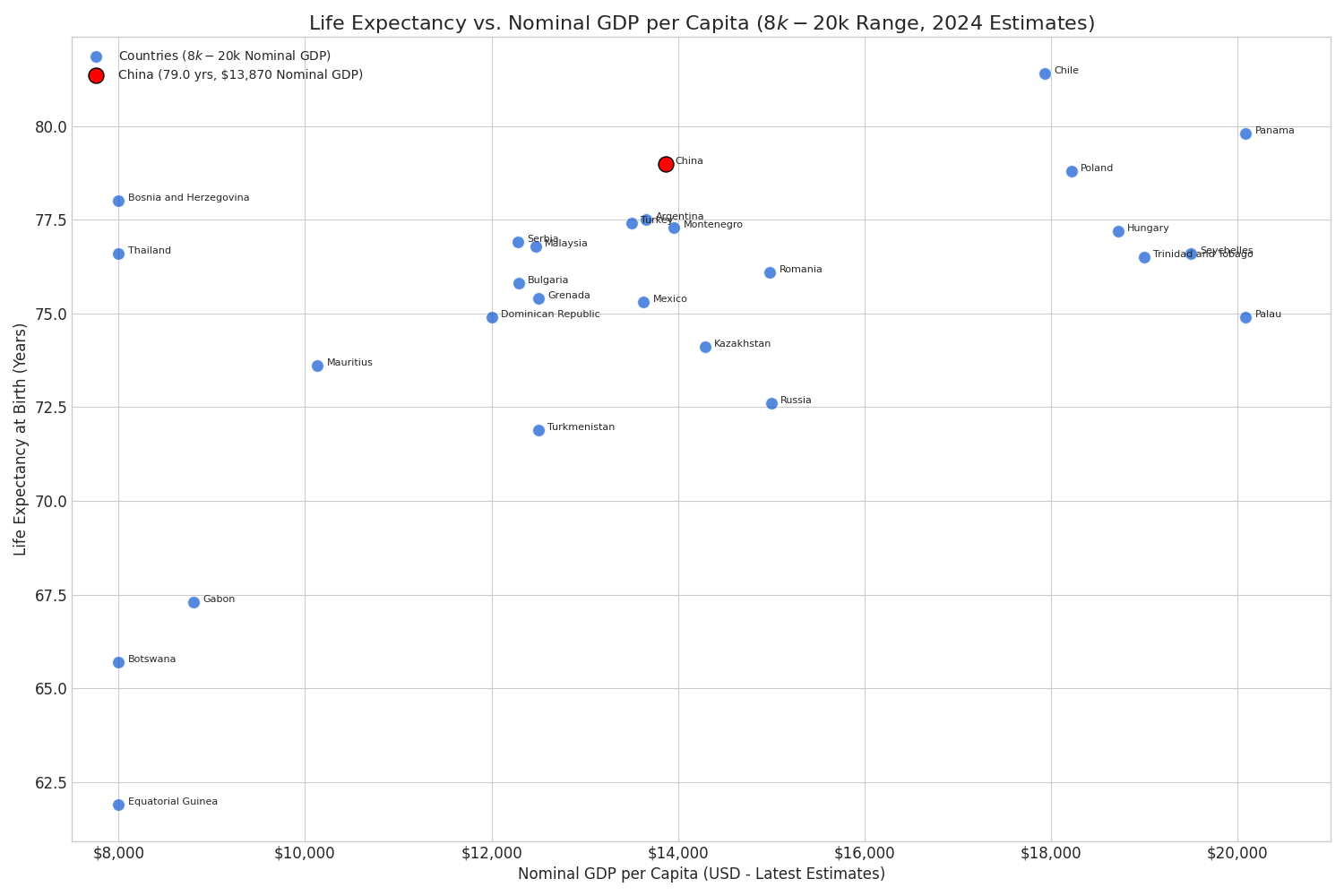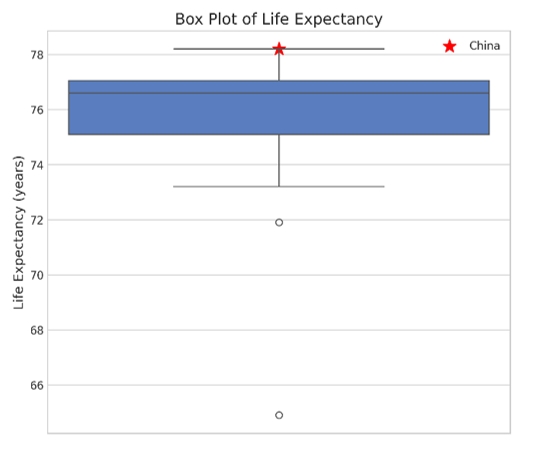
China has achieved remarkable progress in life expectancy, reaching 79 years in 2024, even surpassing the United States (76.1 years) and representing an increase of 0.4 years from 2023, according to the country’s National Health Commission. China's average life expectancy has shown consistent improvement over recent decades, demonstrating the country's commitment to public health advancement. This achievement notably fulfills ahead of schedule the goals set in China's national health plan for the 14th Five-Year Plan period (2021-2025).
Historical data from various sources confirms this upward trajectory. The World Bank reported China's life expectancy at 78.59 years in 2022, while CEIC data showed 78.2 years in 2021. When examining longer-term trends, China has made remarkable progress, having increased life expectancy from approximately 67.77 years in 1981 to its current level. This represents more than a decade of additional life expectancy gained over approximately forty years.
Regional disparities exist within China, with eight well-off municipalities and provinces already exceeding 80 years of life expectancy, including Beijing, Tianjin, Shanghai, Shandong, Jiangsu, Zhejiang, Guangdong, and Hainan. This indicates that China's most developed regions have already achieved life expectancy levels comparable to many high-income nations.
As an upper-middle-income country by World Bank classification, China's appropriate comparison group consists of nations with similar economic development. The World Bank defines upper-middle-income economies as those with per capita GNI between $4,516 and $14,005 (2023), and China's GDP per capita of approximately $13,340 in 2024 places it near the upper threshold of this category.
When comparing China with other upper-middle-income countries, a clear pattern emerges. The dataset compiled for this analysis includes 15 upper-middle-income countries with their respective life expectancy values: China 78.2, Iran 77.8, Colombia 77.3, Turkey 77.1, Ecuador 77.0, Argentina 76.7, Peru 76.7, Thailand 76.6, Malaysia 76.2, Brazil 76.0, Mexico 75.3, Bulgaria 74.9, Russia 73.2, Indonesia 71.9, South Africa 64.9.
Then we use Z-scores to standardize the life expectancy data, allowing us to see how far each country's life expectancy deviates from the average life expectancy of the group, measured in standard deviations. This is particularly valuable when a single year difference in life expectancy can be highly significant. By converting the raw life expectancy values to Z-scores, we can easily identify countries with exceptionally high or low life expectancies relative to the mean, highlighting those where even small differences represent substantial deviations from the norm.

As visualized in the bar chart, China clearly leads this group with the highest life expectancy. The average life expectancy across all these countries is 75.32 years with a standard deviation of 3.34 years. This places China approximately 0.86 standard deviations above the mean, suggesting a notably strong performance relative to its economic peers.

Relationship Between GDP and Life Expectancy
The scatter plot examining the relationship between GDP per capita and life expectancy provides crucial insights. While there is a general positive correlation between economic development and life expectancy among upper-middle-income countries, China notably outperforms what would be expected based on this relationship. Despite having comparable GDP per capita to countries like Montenegro and Mexico, China achieves significantly higher life expectancy. It also outperforms richer countries such as Hungary. This suggests that factors beyond pure economic development are contributing to China's health outcomes.

The box plot visualization positions China as the red star marker above the interquartile range (IQR) of the dataset, further supporting its potential outlier status. This visual representation clearly demonstrates China's exceptional position relative to the overall distribution of life expectancy values among comparable countries.
China's remarkable life expectancy, exceeding that of many economically comparable nations, is increasingly attributed to its distinct dietary patterns and rigorous food safety standards. An in-depth analysis reveals a multifaceted approach that prioritizes both nutritional intake and consumer protection.
China's dietary strengths are rooted in a culture that emphasizes fresh, plant-based foods.
Vegetable Abundance: Chinese residents consume an average of 440 kg of vegetables annually, dwarfing the U.S. consumption of 77 kg. This high intake of fiber-rich and antioxidant-laden vegetables significantly reduces the risk of cardiovascular diseases and cancers. Correspondently, China's per capita vegetable production is on a steady increase, projected to rise from 532.9 kilograms in 2024 to 551.69 kilograms by 2028, reflecting continuous growth. In fact, the country has emerged as a global vegetable production leader: China's agricultural prowess is evident in its 22.87 million hectares dedicated to vegetable production in 2021, yielding over 600 million metric tons of fresh vegetables—nearly half of the world's total.
Robust Protein Intake: Affordable meat prices and stable supply chains, including pork and soy imports, ensure that China's protein intake surpasses that of the U.S. Specifically, China employs a multifaceted approach to manage meat markets, utilizing price controls for pork through a frozen reserve, import adjustments, and regulated breeding sow populations, while beef market management involves investigating import impacts and encouraging optimized herd sizes; these sector-specific strategies are underpinned by general market regulations that seek to balance supply and demand, adjusting production to consumption trends and providing economic support to farmers to ensure both producer profitability and consumer price stability. These measures lead to superior protein consumption metrics: Despite a lower per capita GDP, China achieved a protein consumption of 124.61 grams per person per day in 2021, slightly surpassing the U.S. figure of 124.33 grams
Plant-Based Protein Dominance: In 2021, approximately 60.5% of China's protein originated from vegetable sources, compared to a mere 31% in the U.S. This plant-dominant protein profile not only supports nutritional needs but also offers substantial environmental benefits.
Balanced Traditional Diet: The traditional Chinese diet, characterized by cereals and vegetables with moderate animal product consumption, is linked to lower risks of adverse health outcomes. This balance contributes to China's life expectancy advantage.
China's commitment to food safety is demonstrated through stringent regulations and proactive measures.
Ban on Growth Promoters: China enforces stricter regulations on additives and drug residues, notably banning ractopamine, a growth promoter still permitted in many other countries, including US, Canada and Australia.
Comprehensive Ban on "Lean Meat Powders": In 2002, China issued a comprehensive ban on "lean meat powders," including ractopamine, clenbuterol, and salbutamol, in animal feed and drinking water. These substances remain legal in approximately 20 countries, including the US, Canada, and Mexico.
Regular Updates to Food Safety Standards: China consistently updates its food safety standards, as seen with the implementation of the new GB 2760-2024 National Food Safety Standard for Uses of Food Additives in February 2025.
Rigorous Food Additive Approval: The National Health Commission employs a rigorous approval process for new food ingredients and additives, ensuring thorough safety evaluations.
Health-Promoting Dietary Guidelines: China's 2016 Dietary Guidelines advocate for reduced red meat consumption and lower salt, oil, and sugar intake, demonstrating a national dedication to healthier dietary patterns.
Maintaining High Standards Amidst Processed Food Growth: Despite increasing processed food consumption, China maintains food safety standards that generally exceed those of comparable nations.
Expanding Regulatory Framework: China continually expands its food safety regulatory framework, with the State Administration for Market Regulation (SAMR) releasing draft proposals for new national standards, showcasing an ongoing commitment to improvement.
Early Adoption of Safety Measures: China's proactive approach is exemplified by its early ban on ractopamine in 2012, ahead of many other countries.
The synergistic effect of these measures offers China dietary advantages. These factors likely contribute significantly to its exceptional life expectancy, setting it apart from other upper-middle-income countries.
1. Universal Medical Coverage
The "Medical Socialism Phase" (2012–present) expanded insurance coverage and primary healthcare accessibility. China's latest medical-security plan for the 14th Five-Year Plan period (2021-2025) establishes a multi-tiered medical-insurance system designed to provide universal coverage that benefits both urban and rural residents in a fair and sustainable way. By 2025, China aims to develop a "more matured medical-insurance system that is equal, law-based, secure, smart and coordinated". This system emphasizes coordinated advancement of demand-side management of medical insurance and supply-side reform of medical services to better serve the public.
2. Effective Public Health Interventions
State-led vaccination programs and chronic disease screenings reduce mortality from infectious and non-communicable diseases. China has successfully reached the 2030 intervention targets for three-dose infant vaccination (90%) and timely birth-dose vaccination (90%), achievements stemming from the early introduction of infant vaccination in 1992 and subsequent integration into the National Expanded Programme on Immunization in 2002. Following the SARS epidemic in 2003, the Chinese government significantly increased its commitment to public health by amending laws on the control of infectious diseases, establishing internet-based disease reporting systems, rebuilding local public health facilities, and launching national free programs to promote coverage of essential diagnostic and treatment services for conditions such as HIV and tuberculosis.
3. Preventing Medical Poverty
A key task in China's healthcare strategy is establishing and improving a long-term mechanism that prevents and reduces the risk of poverty or return to poverty caused by illness. This approach addresses a significant social determinant of health by ensuring that medical expenses don't drive families into financial hardship. The National Healthcare Security Administration continues efforts to optimize spending of medical-insurance funds and dynamically adjust the catalog of medicines covered by medical insurance to incorporate more cost-effective items.
4. Improved Healthcare Access
China's 2009 health reform aimed to provide all citizens with affordable and equitable basic healthcare, with the government substantially increasing funding to expand public health insurance coverage and strengthen healthcare infrastructure. This led to rapid increases in physical access and healthcare utilization throughout the country. Additionally, the government is further improving mechanisms for trans-provincial on-the-spot settlement of medical bills via medical-insurance accounts and expanding coverage along with better smart online services.
1. Strategic Health Initiatives
The "Healthy China" initiative restricts advertising for high-salt/sugar foods and promotes low-sodium diets. In 2019, the Chinese government debuted "Love with Less Salt," the country's first major mass media campaign dramatically depicting the dangers of high salt diets common in China. This eight-week campaign, running on China Central Television and in provinces with a combined population exceeding 160 million people, forms the cornerstone of the government's effort to reduce salt consumption by 20% by 2030. The campaign was coordinated through China's National Health Commission, Shandong and Anhui Health Commissions, and provincial Centers for Disease Control and Prevention.
2. Public Education and Awareness Challenges
Public health education has improved awareness, though daily salt intake remains high (10.5 grams), more than double the amount recommended by the World Health Organization and among the highest in the world. Research highlights a persistent need for better education about the link between hypertension and salt intake, particularly in Northern China, where 70% of the population remains unaware of the recommended upper limit of salt intake and associated health damage. About 85.5% of people in these regions have never received formal salt-related health education. Studies indicate that many Chinese people incorrectly believe salt is a source of energy and essential for the human body, with some believing salt is particularly important after exercise to replace sweat loss.
3. Multi-Level Policy Implementation
China's approach to health policy implementation involves coordination between national and provincial authorities, as demonstrated by collaborative development of public health campaigns and medical insurance reforms. The medical-security plan highlights the importance of collaborative governance, with efforts made to build a supporting system with solid legal basis and better digital services. This approach optimizes multi-tiered healthcare delivery while addressing regional health disparities.
1. Infrastructure and Environmental Health
Economic growth and infrastructure upgrades (e.g., clean water, sanitation) reduced infectious disease transmission. China has made tremendous progress in providing safe water and adequate sanitation over recent decades, though gaps remain. A 2008 study found approximately 327 million people in China lacked access to piped drinking water and 535 million lacked access to improved sanitation, leading to hundreds of millions of cases of diarrheal, parasitic, and other infectious diseases. Since then, continued improvements in sanitation conditions, especially in rural China, have significantly reduced these numbers.
2. Urban-Rural Disparities
Education and healthcare resource allocation have narrowed urban-rural health gaps, with eight provinces exceeding 80-year life expectancy. However, research shows persistent inequality in health services utilization in both rural and urban areas of China. Interestingly, there are different patterns of healthcare inequity: urban areas show greater inequity in outpatient service use compared to rural areas (horizontal inequity index [HI] = 0.085 vs 0.029), while rural areas demonstrate greater inequity in inpatient service use compared to urban areas (HI = 0.21 vs 0.16). According to decomposition analysis, household income makes the greatest pro-rich contribution to inequality in both rural and urban China, while chronic diseases and aging are also important contributors to inequality specifically in rural areas.
3. Regional Health Equity Improvements
Despite persistent disparities, China has made progress in reducing regional health inequities. The National Health Commission reports that "disparities in health levels among provincial regions are gradually decreasing, indicating that health equity is improving steadily". This progress is reflected in the narrowing gap between urban and rural life expectancy and in improved health outcomes across provinces. The comprehensive health strategies implemented in recent decades have contributed to more equitable health outcomes nationwide, though continued efforts are needed to address remaining disparities.
Despite these achievements, Lei Haichao, the head of National Health Commission, acknowledged that "China still faces challenges from both infectious and chronic non-communicable diseases," suggesting that "there remains significant potential to increase life expectancy" further. This indicates ongoing opportunities for continued improvement in coming years.
In fact, as life expectancy extends, China currently grapples with an overwhelming burden of chronic non-communicable diseases (NCDs), which constitute a major public health crisis. NCDs account for a staggering 91% of all deaths within the country, with China representing 25.9% of global NCD-related deaths despite housing only 17.9% of the world's population. In 2021 alone, these diseases were responsible for approximately 10.6 million deaths and 349.3 million disability-adjusted life years (DALYs). This underscores the immense impact of NCDs on China's health landscape.
Specific NCDs, such as cardiovascular diseases (CVDs) and cancer, contribute significantly to this burden. In 2019, China saw about 12.3 million new CVD cases and 4.6 million CVD-related deaths, resulting in 91.9 million DALYs. The incidence of CVDs is on the rise, with stroke and ischemic heart disease being primary culprits, and crude CVD mortality is projected to increase substantially by 2050 due to population growth and aging, even with decreasing age-standardized mortality rates. Cancer also presents a major challenge, with incidence rates climbing over the past decades. Additionally, chronic respiratory diseases and diabetes are increasingly prevalent, linked to lifestyle changes and environmental factors. Regional disparities further complicate the situation, with provinces like Qinghai, Xizang, and Heilongjiang exhibiting higher age-standardized mortality and DALY rates for NCDs compared to more developed areas.
In response to this escalating crisis, China has implemented several public health initiatives. The "Healthy China 2030 Plan" aims to reduce premature mortality from major NCDs through integrated prevention and control strategies. National Demonstration Areas for Integrated Chronic and Non-communicable Disease Prevention and Control (NCDDA) are being established to strengthen community-based NCD prevention efforts. These initiatives reflect the government's recognition of the critical need for targeted public health strategies to effectively address the pervasive challenges posed by NCDs.
On the other hand, China's healthcare system is plagued by significant inequities and operational challenges. A stark urban-rural divide exists, with urban centers boasting superior facilities and personnel, while rural areas suffer from limited resources and accessibility. This geographical disparity is compounded by financial burdens, as substantial out-of-pocket payments and insufficient medical insurance funds hinder access to necessary care. Furthermore, issues regarding quality and efficiency persist, including overcrowding in tertiary hospitals, long waiting times, and corruption that undermines trust and inflates costs. The workforce faces a "know-do" gap, particularly in resource-limited regions, and an uneven distribution of professionals exacerbates these problems, with central and western regions struggling to attract and retain talent.
Adding to these systemic flaws, China's aging population presents a growing demand for chronic disease management and long-term care, straining the current system's capacity. These challenges underscore the urgent need for comprehensive reforms to enhance equity, efficiency, and quality within China's healthcare framework. Addressing these issues is crucial for ensuring that all citizens have access to effective and affordable healthcare, and for adapting the healthcare system to the evolving demographic and epidemiological landscape.
The comprehensive analysis of life expectancy data clearly establishes China as a statistical outlier among upper-middle-income countries. With a life expectancy of 79 years in 2024, China significantly outperforms what would be expected based on its economic development level alone. This finding is supported by multiple statistical tests and visualizations that consistently position China at the upper end of the distribution among comparable nations.
Despite the remaining challenges in its healthcare system and persisting urban-rural disparity, China's exceptional performance likely reflects a combination of effective health policies, improving healthcare infrastructure, cultural factors supporting healthy lifestyles, and consistent long-term focus on public health improvement. As China continues its economic development trajectory toward high-income status, its life expectancy achievements provide valuable policy insights for other developing nations seeking to translate economic growth into improved health outcomes.
These findings highlight that economic development alone does not determine health outcomes, and that targeted public health initiatives can produce results that exceed expectations based on income level. For countries seeking to maximize life expectancy gains, China's experience offers a compelling case study in effective health policy implementation within the constraints of middle-income country resources.